Eviews格兰杰因果关系检验结果说明
格兰杰因果检验
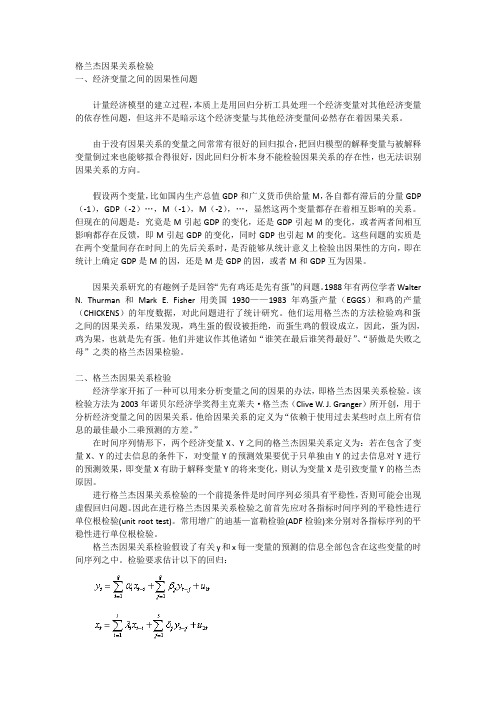
格兰杰因果关系检验一、经济变量之间的因果性问题计量经济模型的建立过程,本质上是用回归分析工具处理一个经济变量对其他经济变量的依存性问题,但这并不是暗示这个经济变量与其他经济变量间必然存在着因果关系。
由于没有因果关系的变量之间常常有很好的回归拟合,把回归模型的解释变量与被解释变量倒过来也能够拟合得很好,因此回归分析本身不能检验因果关系的存在性,也无法识别因果关系的方向。
假设两个变量,比如国内生产总值GDP和广义货币供给量M,各自都有滞后的分量GDP (-1),GDP(-2)…,M(-1),M(-2),…,显然这两个变量都存在着相互影响的关系。
但现在的问题是:究竟是M引起GDP的变化,还是GDP引起M的变化,或者两者间相互影响都存在反馈,即M引起GDP的变化,同时GDP也引起M的变化。
这些问题的实质是在两个变量间存在时间上的先后关系时,是否能够从统计意义上检验出因果性的方向,即在统计上确定GDP是M的因,还是M是GDP的因,或者M和GDP互为因果。
因果关系研究的有趣例子是回答“先有鸡还是先有蛋”的问题。
1988年有两位学者Walter N. Thurman和Mark E. Fisher用美国1930——1983年鸡蛋产量(EGGS)和鸡的产量(CHICKENS)的年度数据,对此问题进行了统计研究。
他们运用格兰杰的方法检验鸡和蛋之间的因果关系,结果发现,鸡生蛋的假设被拒绝,而蛋生鸡的假设成立,因此,蛋为因,鸡为果,也就是先有蛋。
他们并建议作其他诸如“谁笑在最后谁笑得最好”、“骄傲是失败之母”之类的格兰杰因果检验。
二、格兰杰因果关系检验经济学家开拓了一种可以用来分析变量之间的因果的办法,即格兰杰因果关系检验。
该检验方法为2003年诺贝尔经济学奖得主克莱夫·格兰杰(Clive W. J. Granger)所开创,用于分析经济变量之间的因果关系。
他给因果关系的定义为“依赖于使用过去某些时点上所有信息的最佳最小二乘预测的方差。
VAR模型、Johansen协整检验在eviews中的具体操作步骤及结果解释

19
利用Genr命令可算得用于检验原假设是否 成立的伴随概率 P:
p=1-@cchisq(42.4250,18) =0.000964
故 P=0.000964< =0.05,应拒绝原假设
,建立VAR(3)模型。
20
三、约翰森(Jonhamson)协整检验
Jonhamson(1995)协整检验是基于VAR模 型的一种检验方法,但也可直接用于多变量间的协 整检验。
1.Johanson协整似然比(LR)检验 H0:有 0个协整关系; H1:有M个协整关系。 检验迹统计量:
N
LRM n
log(1 i )
i M 1
图11-1和图11-2,由图11-2可以看出,三个对数序列的
变化趋势基本一致,可能存在协整关系。
13
160000
120000
80000
40000
0 55 60 65 70 75 80 85 90 95 00
GDP
CT
IT
图11-1 GDPt、 Ct和 It
的时序图
12
11
10
9
8
7
6
5 55 60 65 70 75 80 85 90 95 00
LR 2(Lnl(1) Lnl(3)) 2(108.7551 129.9676) 42.4250
其中,Lnl(1)和Lnl(3)分别为P=1和P=3时VAR(P) 模型的对数似然函数值。在零假设下,该统计量 服从渐进的 2 ( f ) 分布,其自由度f为从VAR(3) 到VAR(1)对模型参数施加的零约束个数。对本 例:
这种方程组模型主要用于分析联合内生变量 间的动态关系。联合是指研究N个变量 y1t y2t yNt 间的相互影响关系,动态是指p期滞后。故称VAR 模型是分析联合内生变量间的动态关系的动态模 型,而不带有任何约束条件,故又称为无约束 VAR模型。建VAR模型的目的:
格兰杰因果检验原理

格兰杰因果检验原理嘿,朋友们!今天咱来聊聊格兰杰因果检验原理。
这玩意儿啊,就像是生活中的一种奇妙关系探索器。
你想啊,在生活中,我们常常会琢磨一些事情之间是不是有某种特别的关联。
比如说,你发现每次你一打喷嚏,天就好像要下雨,那打喷嚏和下雨之间是不是有啥因果关系呢?格兰杰因果检验原理就像是个超级侦探,专门来探究这些关系。
它可不是随便看看就下结论的哦!它会仔细分析数据,从各种角度去研究。
比如说,A 事件发生在前,B 事件跟着就来了,那是不是 A 导致了 B 呢?但这可没那么简单,不能光看先后顺序呀,还得看它们之间是不是真的有那种内在的、稳定的联系。
好比说,你每天早上喝杯咖啡,然后就觉得精神特别好。
但到底是喝咖啡让你精神好呢,还是你本来就会精神好,喝咖啡只是个巧合呢?格兰杰因果检验原理就会去深入挖掘这些细节,试图找出真正的答案。
它就像是个严谨的裁判,不会轻易被表面现象迷惑。
它要的是确凿的证据,要确定这个因果关系是真的存在,而不是我们自己想象出来的。
再打个比方,你觉得自己每次穿红色衣服出门就会遇到好事,这真的是因为穿红色衣服导致的吗?也许只是巧合呢?格兰杰因果检验原理会帮你搞清楚这到底是怎么回事。
这原理在很多领域都大有用处呢!经济学里可以用它来看看不同经济变量之间的关系,医学里可以用它来研究某种治疗方法和康复效果之间有没有因果联系。
你说这格兰杰因果检验原理是不是特别神奇?它就像一把钥匙,能打开我们对事物之间关系认知的大门。
让我们能更准确地理解这个世界,知道什么是真正的因果,而不是被一些虚假的关联所误导。
总之,格兰杰因果检验原理是个非常有价值的工具,能帮助我们在复杂的世界中找到真正的因果关系。
它让我们不再盲目地相信一些表面的联系,而是用科学的方法去分析、去验证。
所以啊,大家可别小瞧了它哟!原创不易,请尊重原创,谢谢!。
EVIEWS各种检验
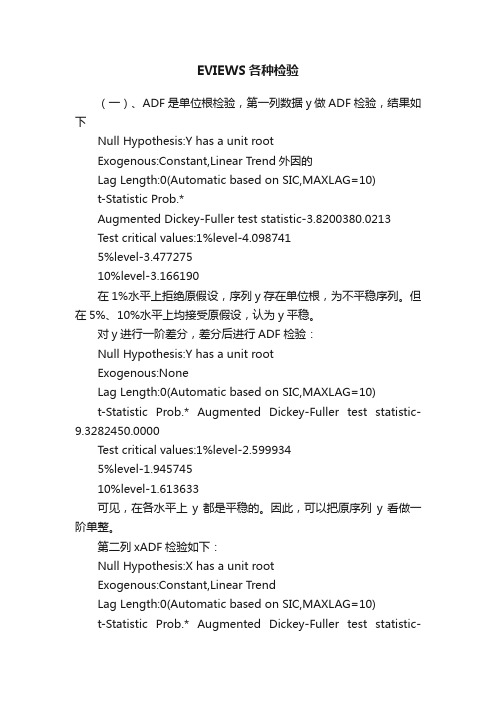
EVIEWS各种检验(一)、ADF是单位根检验,第一列数据y做ADF检验,结果如下Null Hypothesis:Y has a unit rootExogenous:Constant,Linear Trend外因的Lag Length:0(Automatic based on SIC,MAXLAG=10)t-Statistic Prob.*Augmented Dickey-Fuller test statistic-3.8200380.0213Test critical values:1%level-4.0987415%level-3.47727510%level-3.166190在1%水平上拒绝原假设,序列y存在单位根,为不平稳序列。
但在5%、10%水平上均接受原假设,认为y平稳。
对y进行一阶差分,差分后进行ADF检验:Null Hypothesis:Y has a unit rootExogenous:NoneLag Length:0(Automatic based on SIC,MAXLAG=10)t-Statistic Prob.* Augmented Dickey-Fuller test statistic-9.3282450.0000Test critical values:1%level-2.5999345%level-1.94574510%level-1.613633可见,在各水平上y都是平稳的。
因此,可以把原序列y看做一阶单整。
第二列xADF检验如下:Null Hypothesis:X has a unit rootExogenous:Constant,Linear TrendLag Length:0(Automatic based on SIC,MAXLAG=10)t-Statistic Prob.* Augmented Dickey-Fuller test statistic-3.2167370.0898Test critical values:1%level-4.0987415%level-3.47727510%level-3.166190在1%、5%水平上拒绝原假设,序列x存在单位根,为不平稳序列。
eviews图像及结果分析

.. 第4章图形和统计量分析EViews软件提供了序列(Series)和序列组(Group)等对象的各种视图、统计分析方法和过程。
当序列对象中输入数据后,就可对序列对象中输入的数据进行统计分析,并且可以通过图、表等形式进行描述。
本章将介绍序列和序列组对象图形的生成和描述性统计量及其检验。
4.1 图形对象图形(Graph)对象可以形成序列和序列组等对象的各种视图,如线图(Line)、散点图(Scatter)以及饼图(Pie)等。
通过图形可以进一步观察和分析数据的变化趋势和规律。
下面介绍图形对象的基本操作。
4.1.1 图形(Graph)对象的生成图形对象也是工作文件中的基本对象之一。
要生成图形对象需首先打开序列对象窗口或序列组对象窗口,选择对象窗口工具栏中的“View”|“Graph”选项。
选择的对象类型不同,将弹出不同的窗口。
如果在序列对象窗口下选择“View”|“Graph”选项,将弹出如图4-1所示的界面。
图4-1 序列窗口下图形对象的生成此时“Graph”弹出的菜单中有6种图形可供选择。
“Line”表示生成的是折线图,如图4-2所示,其横轴表示时间或序列的顺序,纵轴表示序列对象观测值的大小。
“Area”表示生成面积图,其图形的形状与“Line”(折线图)相同,不同的是“Area”(面积图)曲线下方是被填满的,而“Line”(折线图)下方是空白。
图4-2 “Line”折线图“Bar”表示为条形图,用条状的高度表示观测值的大小。
“Spike”表示尖峰图,由竖线组成,每根竖线的高度代表观测值的大小。
“Seasonal Stacked Line”表示生成的是季节性堆叠图,“Seasonal Split Line”表示生成的是季节性分割线。
如果在序列组(群)对象窗口下选择“View”|“Graph”选项,将弹出如图4-3所示的界面。
这里有9种图形可供选择。
其前4种与上面讲述的相同。
图4-3 序列组(群)窗口下图对象的生成其中,“Scatter”表示生成散点图。
Eviews格兰杰因果关系检验结果说明

Eviews格兰杰因果关系检验结果说明一、经济变量之间的因果性问题计量经济模型的建立过程,本质上是用回归分析工具处理一个经济变量对其他经济变量的依存性问题,但这并不是暗示这个经济变量与其他经济变量间必然存在着因果关系。
由于没有因果关系的变量之间常常有很好的回归拟合,把回归模型的解释变量与被解释变量倒过来也能够拟合得很好,因此回归分析本身不能检验因果关系的存在性,也无法识别因果关系的方向。
假设两个变量,比如国内生产总值GDP和广义货币供给量M,各自都有滞后的分量GDP(-1),GDP(-2)…,M(-1),M(-2),…,显然这两个变量都存在着相互影响的关系。
但现在的问题是:究竟是M引起GDP的变化,还是GDP引起M的变化,或者两者间相互影响都存在反馈,即M引起GDP的变化,同时GDP也引起M的变化。
这些问题的实质是在两个变量间存在时间上的先后关系时,是否能够从统计意义上检验出因果性的方向,即在统计上确定GDP是M的因,还是M是GDP的因,或者M和GDP互为因果。
因果关系研究的有趣例子是回答“先有鸡还是先有蛋”的问题。
1988年有两位学者Walter N. Thurman和Mark E. Fisher用美国1930——1983年鸡蛋产量(EGGS)和鸡的产量(CHICKENS)的年度数据,对此问题进行了统计研究。
他们运用格兰杰的方法检验鸡和蛋之间的因果关系,结果发现,鸡生蛋的假设被拒绝,而蛋生鸡的假设成立,因此,蛋为因,鸡为果,也就是先有蛋。
他们并建议作其他诸如“谁笑在最后谁笑得最好”、“骄傲是失败之母”之类的格兰杰因果检验。
二、格兰杰因果关系检验strengthen the sense of responsibility, work to solve the lack of decent occupation explain away, conduct problems. To establish theoverall concept, eliminate departmentalism. Strict assessment and accountability, to solve the spiritual slack, nianqingpazhong, status quo, and other issues. To establish and perfect the muddle along Bureau staff conduct work regulations, standardize the behavior of personnel. 2. To strengthen the responsibility system. One is the in-depth study and implement the "Hunan provincial Party and government leading cadres Interim Provisions on the work safety of a pair of > (Hunan Officeissued 2013 No. 5)," Hunan province safety supervision and management responsibilities of the provisions on the production (Hunan Zhengban made 2013 No. 4) And resolutely implement the safety production of the party with responsibility, a pair of responsibility. "Two is issued safety production administration and inspection to promote the responsibilities bear safety production supervision departments strictly and effectively assumed responsibility. The three is to establish risk self correction self reporting system for safety in production enterprises, promote the enterprises to implement the mainresponsibility for production safety is introduced. Four strengthen the county safety production supervision ability construction work, promote safe production responsibility to the grassroots. 3, strictaccountability and target management. Adhere to the" who is in charge, who is responsible for the pipe industry must be safe, Guan Sheng production and operation must be safe, pipe business must controlsecurity "principle, the implementation of safety The production of "cure." stagnation supervision and leadership responsible system. The safety production of key towns, key enterprises and key problems, by the township government and the Department responsible for the stagnationled the lump sum, to tackle tough. To further increase the production safety index assessment, strictly implement the safety production of the "one vote veto" and the reward system, strengthen the safety incentive and restraint mechanism. (six) the implementation of the work force is not strong. The documents, meeting, long work arrangement, check and supervise the implementation of small, poor implementation of the system, the work is not effective. Some leading cadres sense of purpose, consciousness of the masses is not strong, the ruling " For the people "," the interests of the masses no matter "concept understanding is not in place. The specific work treats with the deployment, a few leading cadres complain that work is too complicated, too much responsibility, the pressure is too large, too much emphasis on the difficulty of the work, such as underground mines to avoid the disaster of" six systems "construction and construction of mechanical ventilation to file the form, forwarding arrangements work, no in-depth mining enterprises to promote the specific work, the increase in the number of files, but the effect is not good, not according to the actual situation of non coal mines in the county, to engage in" across the board ", and the quality 经济学家开拓了一种可以用来分析变量之间的因果的办法,即格兰杰因果关系检验。
格兰杰因果检验
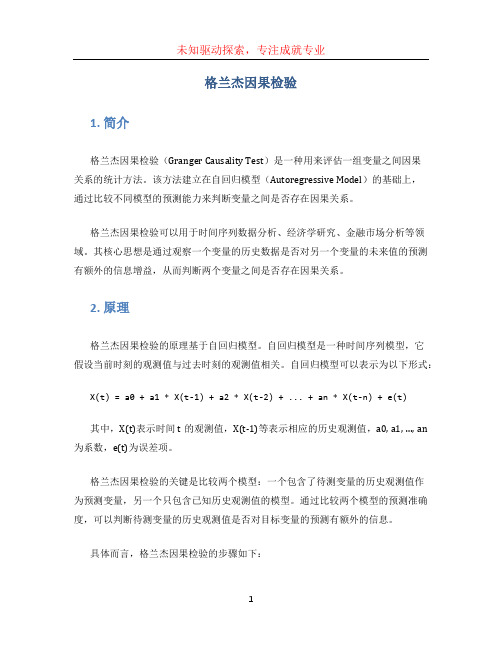
格兰杰因果检验1. 简介格兰杰因果检验(Granger Causality Test)是一种用来评估一组变量之间因果关系的统计方法。
该方法建立在自回归模型(Autoregressive Model)的基础上,通过比较不同模型的预测能力来判断变量之间是否存在因果关系。
格兰杰因果检验可以用于时间序列数据分析、经济学研究、金融市场分析等领域。
其核心思想是通过观察一个变量的历史数据是否对另一个变量的未来值的预测有额外的信息增益,从而判断两个变量之间是否存在因果关系。
2. 原理格兰杰因果检验的原理基于自回归模型。
自回归模型是一种时间序列模型,它假设当前时刻的观测值与过去时刻的观测值相关。
自回归模型可以表示为以下形式:X(t) = a0 + a1 * X(t-1) + a2 * X(t-2) + ... + an * X(t-n) + e(t)其中,X(t)表示时间t的观测值,X(t-1)等表示相应的历史观测值,a0, a1, …, an 为系数,e(t)为误差项。
格兰杰因果检验的关键是比较两个模型:一个包含了待测变量的历史观测值作为预测变量,另一个只包含已知历史观测值的模型。
通过比较两个模型的预测准确度,可以判断待测变量的历史观测值是否对目标变量的预测有额外的信息。
具体而言,格兰杰因果检验的步骤如下:1.确定待测变量和目标变量;2.构建自回归模型,选择合适的滞后阶数n;3.利用已知的历史观测值进行模型的参数估计;4.比较两个模型的预测能力,利用一定的统计指标(如均方根误差、F-统计量)来评估预测准确度;5.根据统计指标的结果,判断待测变量是否对目标变量的预测有额外的信息,从而判断两个变量之间是否存在因果关系。
3. 实例分析为了更好地理解格兰杰因果检验的应用,下面我们以一个具体的实例来说明。
假设我们有两个时间序列变量:A和B,其中A表示每个月的平均气温,B表示每个月的销售额。
我们想要判断气温是否影响销售额。
EVIEWS格兰杰检验解读
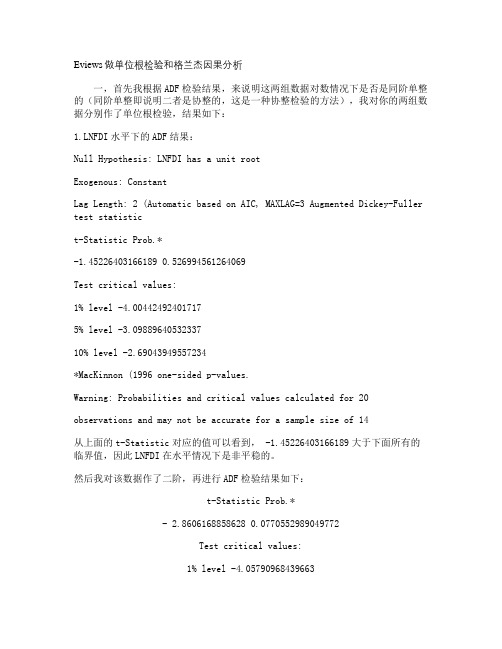
Eviews做单位根检验和格兰杰因果分析一,首先我根据ADF检验结果,来说明这两组数据对数情况下是否是同阶单整的(同阶单整即说明二者是协整的,这是一种协整检验的方法),我对你的两组数据分别作了单位根检验,结果如下:1.LNFDI水平下的ADF结果:Null Hypothesis: LNFDI has a unit rootExogenous: ConstantLag Length: 2 (Automatic based on AIC, MAXLAG=3 Augmented Dickey-Fuller test statistict-Statistic Prob.*-1.45226403166189 0.526994561264069Test critical values:1% level -4.004424924017175% level -3.0988964053233710% level -2.69043949557234*MacKinnon (1996 one-sided p-values.Warning: Probabilities and critical values calculated for 20observations and may not be accurate for a sample size of 14从上面的t-Statistic对应的值可以看到, -1.45226403166189大于下面所有的临界值,因此LNFDI在水平情况下是非平稳的。
然后我对该数据作了二阶,再进行ADF检验结果如下:t-Statistic Prob.*- 2.8606168858628 0.0770552989049772Test critical values:1% level -4.057909684396635% level -3.1199095651240810% level -2.70110325490427看到t-Statistic的值小于10% level下的-2.70110325490427,因此可以认为它在二阶时,有90%的可能性,是平稳的。
格兰杰因果关系检验
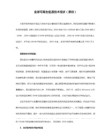
年份
1990 1991 1992 1993 1994 1995 1996 1997 1998 1999
CONS
9113.2 10315.9 12459.8 15682.4 20809.8 26944.5 32152.3 34854.6 36921.1 39334.4
GDP
18319.5 21280.4 25863.7 34500.7 46690.7 58510.5 68330.4 74894.2 79003.3 82673.1
判断:=5%,临界值F0.05(2,17)=3.59
拒绝“GDP不是CONS的格兰杰原因”的假设,不 拒绝“CONS不是GDP的格兰杰原因”的假设。
因此,从2阶滞后的情况看,GDP的增长是居民 消费增长的格兰杰原因,而相反不是。
中国GDP与居民消费CONS的格兰杰因果检验
判断结果是:GDP与CONS有双向的格兰杰因果关系, 即相互影响。
年份
1978 1979 1980 1981 1982 1983 1984 1985 1986 1987
CONS
1759.1 2005.4 2317.1 2604.1 2867.9 3182.5 3674.5 4589 5175 5961.2
GDP
3605.6 4074 4551.3 4901.4 5489.2 6076.3 7164.4 8792.1 10132.8 11784.7
但究竟是GDP的增长导致了M2的增加,还是M2
增加促进了GDP的增长,或者两者互为因果关系,
从理论和实践两方面来回答这个问题,就不是很
简单的问题
二、格兰杰因果关系检验
(一)格兰杰检验的基本思想是“过去可以预测现在”
如果X是Y变化的原因,则 X的变化应当发生在 Y
格兰杰因果关系检验

例二
经过Eviews进行格兰杰检验结果如下
可以看出在滞后期为2的情况下,两者互为原因,不 符合格兰杰因果检验。
例三
经过Eviews进行格兰杰检验结果如下 可以看出在滞后期为2的情况下,两者互不为原因。
四、格兰杰因果检验的评价
• 格兰杰的统计学本质上是对平稳时间序列数据一种预测,格兰杰 因果关系检验的结论只是一种预测,是统计意义上的格兰杰因果 性,而不是真正意义上的因果关系,不能作为肯定或否定因果关 系的根据。
二、Granger因果关系检验
变量X是否为变量Y的Granger原因,是可以检验的。
检验X是否为引起Y变化的Granger原因的过程如下:
第一步,检验原假设“H0:X不是引起Y变化的
Granger原因”。首先,估计下列两个回
t 0 i1 i t i i1 i t i t
降水量 20 5 5 15 8 15 41 23 39 5 47 30 28 81 137 35 41 31 57 18 93 67 1 15 10 9
解:(1)建立工作文件。
由于本例数据的时间间隔为旬,Eviews没有提供相应的时 期度量,故应利用鼠标左键单击主菜单选项File,在打开 的下拉菜单中选择New/Workfile,并在工作文件定义对话 框(Workfile Range)的Workfile frequency一栏选择 Undated or irregular项。在起止项中分别输入1和78,表 示每个序列的观测值个数为78个。
有约束回归模型(r): Y
p
Y
t 0 i 1 i t i t
式中,0表示常数项;p和q分别为变量Y和X的最大滞后期 数,通常可以取的稍大一些;t为白噪声。
• 然后,用这两个回归模型的残差平方和RSSu和RSSr 构造F统计量:
Eviews格兰杰因果关系检验结果说明

Eviews格兰杰因果关系检验结果说明一、经济变量之间的因果性问题计量经济模型的建立过程,本质上是用回归分析工具处理一个经济变量对其他经济变量的依存性问题,但这并不是暗示这个经济变量与其他经济变量间必然存在着因果关系。
由于没有因果关系的变量之间常常有很好的回归拟合,把回归模型的解释变量与被解释变量倒过来也能够拟合得很好,因此回归分析本身不能检验因果关系的存在性,也无法识别因果关系的方向。
假设两个变量,比如国内生产总值GDP和广义货币供给量M,各自都有滞后的分量GDP(-1),GDP(-2)…,M(-1),M(-2),…,显然这两个变量都存在着相互影响的关系。
但现在的问题是:究竟是M引起G DP的变化,还是GDP引起M的变化,或者两者间相互影响都存在反馈,即M引起GDP的变化,同时GDP也引起M的变化。
这些问题的实质是在两个变量间存在时间上的先后关系时,是否能够从统计意义上检验出因果性的方向,即在统计上确定GDP是M的因,还是M是GDP的因,或者M和GDP互为因果。
因果关系研究的有趣例子是回答“先有鸡还是先有蛋”的问题。
1988年有两位学者Wal ter N. Thurman和MarkE. Fisher用美国1930——1983年鸡蛋产量(EGGS)和鸡的产量(CHICKEN S)的年度数据,对此问题进行了统计研究。
他们运用格兰杰的方法检验鸡和蛋之间的因果关系,结果发现,鸡生蛋的假设被拒绝,而蛋生鸡的假设成立,因此,蛋为因,鸡为果,也就是先有蛋。
他们并建议作其他诸如“谁笑在最后谁笑得最好”、“骄傲是失败之母”之类的格兰杰因果检验。
二、格兰杰因果关系检验经济学家开拓了一种可以用来分析变量之间的因果的办法,即格兰杰因果关系检验。
该检验方法为2003年诺贝尔经济学奖得主克莱夫·格兰杰(Clive W. J. Granger)所开创,用于分析经济变量之间的因果关系。
Eviews第四讲格兰杰因果 ppt课件

Eviews第四讲格兰杰因果
模型及步骤: 1. 单位根检验,得出数据平稳I(0) 2. 格兰杰因果检验 3. 平稳数据可进行OLS/ VAR(脉冲反应/
方差分解)
Eviews第四讲格兰杰因果
模型及步骤: 1. 单位根检验,得出数据平稳I(1)或I(2) 2.协整检验 (3. 格兰杰因果检验) 4. VAR (误差修正模型)--数据不平稳
Eviews第四讲格兰杰因果
得到平稳的序列X,Y后,我们开始进行格 兰杰因果检验
1. 选定变量Y,X,open—as group 2. view---Granger causality
Eviews第四讲格兰杰因果
Eviews第四讲格兰杰因果
Eviews第四讲格兰杰因果
Eviews第四讲格兰杰因果
causality,输入滞后项后确定 (最优滞后阶数由AIC准则确定)
Eviews第四讲格兰杰因果
1. 差分法 首先对时间序列进行单位根检验,若序列是一
阶单整:Y—I(1), X—I(1),则通过一阶差分使 得序列平稳 Eviews里可以通过命令:
genr dY=D(Y) genr dX=D(X)
先做单位根检验,看变量序列是否平稳 序列,若平稳,可构造回归模型等经典 计量经济学模型;若非平稳,进行差分 ,当进行到第i次差分时序列平稳,则服 从i阶单整(注意趋势、截距不同情况选 择,根据P值和原假设判定)。
Eviews第四讲格兰杰因果
若所有检验序列均服从同阶单整,可构 造VAR模型,做协整检验(注意滞后期的 选择),判断模型内部变量间是否存在 协整关系,即是否存在长期均衡关系。 如果有,则可以构造VEC模型或者进行 Granger因果检验,检验变量之间“谁引 起谁变化”,即因果关系。
格兰杰因果检验解读
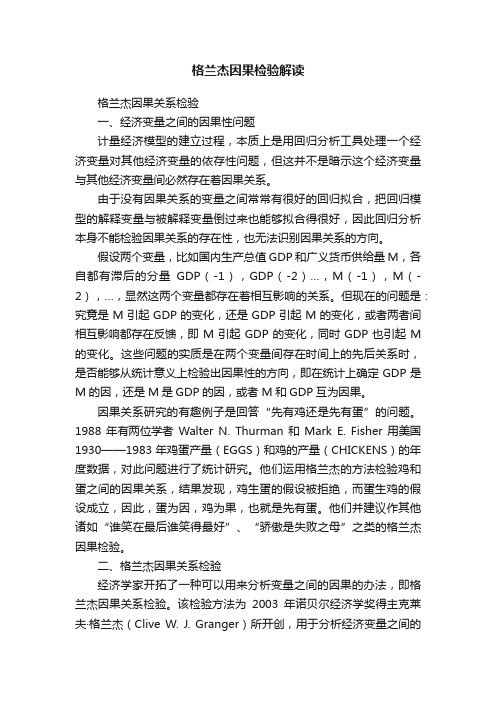
格兰杰因果检验解读格兰杰因果关系检验一、经济变量之间的因果性问题计量经济模型的建立过程,本质上是用回归分析工具处理一个经济变量对其他经济变量的依存性问题,但这并不是暗示这个经济变量与其他经济变量间必然存在着因果关系。
由于没有因果关系的变量之间常常有很好的回归拟合,把回归模型的解释变量与被解释变量倒过来也能够拟合得很好,因此回归分析本身不能检验因果关系的存在性,也无法识别因果关系的方向。
假设两个变量,比如国内生产总值GDP和广义货币供给量M,各自都有滞后的分量GDP(-1),GDP(-2)…,M(-1),M(-2),…,显然这两个变量都存在着相互影响的关系。
但现在的问题是:究竟是M引起GDP的变化,还是GDP引起M的变化,或者两者间相互影响都存在反馈,即M引起GDP的变化,同时GDP也引起M 的变化。
这些问题的实质是在两个变量间存在时间上的先后关系时,是否能够从统计意义上检验出因果性的方向,即在统计上确定GDP是M的因,还是M是GDP的因,或者M和GDP互为因果。
因果关系研究的有趣例子是回答“先有鸡还是先有蛋”的问题。
1988年有两位学者Walter N. Thurman和Mark E. Fisher用美国1930——1983年鸡蛋产量(EGGS)和鸡的产量(CHICKENS)的年度数据,对此问题进行了统计研究。
他们运用格兰杰的方法检验鸡和蛋之间的因果关系,结果发现,鸡生蛋的假设被拒绝,而蛋生鸡的假设成立,因此,蛋为因,鸡为果,也就是先有蛋。
他们并建议作其他诸如“谁笑在最后谁笑得最好”、“骄傲是失败之母”之类的格兰杰因果检验。
二、格兰杰因果关系检验经济学家开拓了一种可以用来分析变量之间的因果的办法,即格兰杰因果关系检验。
该检验方法为2003年诺贝尔经济学奖得主克莱夫·格兰杰(Clive W. J. Granger)所开创,用于分析经济变量之间的因果关系。
他给因果关系的定义为“依赖于使用过去某些时点上所有信息的最佳最小二乘预测的方差。
E-view格兰杰检验步骤

以1978~2006年间实际可支配收入(X)和居民实际消费总支出(Y)之间的因果关系为例,做格兰杰检验
1.点击E-view主画面顶部按钮File/New/Workfile,如下图
弹出下图
2.在上图中的Workfile frequency中选择Annual,并输入Start date:1978 和End date:
2006,点击OK,如下图所示
3.再点击主画面中Objects/New Object,弹出如下窗口
4.选择Group,并在Name for Object框输入你要定义的名字如g1,得到下图
5.点击obs右边的单元格,此时该单元格下方所在列会变蓝,如图
在对话框中输入变量名称X,Y及其变量值
6.点击主页面Quick/Group Statistics/Granger Causality Test,得到下图
输入y x,点击Ok,得到下图,
将2改为1点击OK得到下图
武汉理工大学杨超上传。
格兰杰因果检验

格兰杰因果关系检验一、经济变量之间的因果性问题计量经济模型的建立过程,本质上是用回归分析工具处理一个经济变量对其他经济变量的依存性问题,但这并不是暗示这个经济变量与其他经济变量间必然存在着因果关系。
由于没有因果关系的变量之间常常有很好的回归拟合,把回归模型的解释变量与被解释变量倒过来也能够拟合得很好,因此回归分析本身不能检验因果关系的存在性,也无法识别因果关系的方向。
假设两个变量,比如国内生产总值GDP和广义货币供给量M,各自都有滞后的分量GDP (-1),GDP(-2)…,M(-1),M(-2),…,显然这两个变量都存在着相互影响的关系。
但现在的问题是:究竟是M引起GDP的变化,还是GDP引起M的变化,或者两者间相互影响都存在反馈,即M引起GDP的变化,同时GDP也引起M的变化。
这些问题的实质是在两个变量间存在时间上的先后关系时,是否能够从统计意义上检验出因果性的方向,即在统计上确定GDP是M的因,还是M是GDP的因,或者M和GDP互为因果。
因果关系研究的有趣例子是回答“先有鸡还是先有蛋”的问题。
1988年有两位学者Walter N. Thurman和Mark E. Fisher用美国1930——1983年鸡蛋产量(EGGS)和鸡的产量(CHICKENS)的年度数据,对此问题进行了统计研究。
他们运用格兰杰的方法检验鸡和蛋之间的因果关系,结果发现,鸡生蛋的假设被拒绝,而蛋生鸡的假设成立,因此,蛋为因,鸡为果,也就是先有蛋。
他们并建议作其他诸如“谁笑在最后谁笑得最好”、“骄傲是失败之母”之类的格兰杰因果检验。
二、格兰杰因果关系检验经济学家开拓了一种可以用来分析变量之间的因果的办法,即格兰杰因果关系检验。
该检验方法为2003年诺贝尔经济学奖得主克莱夫·格兰杰(Clive W. J. Granger)所开创,用于分析经济变量之间的因果关系。
他给因果关系的定义为“依赖于使用过去某些时点上所有信息的最佳最小二乘预测的方差。
Eviews做单位根检验和格兰杰因果分析

Eviews做单位根检验和格兰杰因果分析一,首先我根据ADF检验结果,来说明这两组数据对数情况下是否是同阶单整的(同阶单整即说明二者是协整的,这是一种协整检验的方法),我对你的两组数据分别作了单位根检验,结果如下:1.LNFDI水平下的ADF结果:Null Hypothesis: LNFDI has a unit rootExogenous: ConstantLag Length: 2 (Automatic based on AIC, MAXLAG=3) Augmented Dickey-Fuller test statistict-Statistic Prob.*-1.45226403166189 0.526994561264069Test critical values:1% level -4.004424924017175% level -3.0988964053233710% level -2.69043949557234*MacKinnon (1996) one-sided p-values.Warning: Probabilities and critical values calculated for 20observations and may not be accurate for a sample size of 14从上面的t-Statistic对应的值可以看到,-1.45226403166189大于下面所有的临界值,因此LNFDI在水平情况下是非平稳的。
然后我对该数据作了二阶,再进行ADF检验结果如下:t-Statistic Prob.*- 2.8606168858628 0.0770552989049772Test critical values:1% level -4.057909684396635% level -3.1199095651240810% level -2.70110325490427看到t-Statistic的值小于10% level下的-2.70110325490427,因此可以认为它在二阶时,有90%的可能性,是平稳的。
eviews格兰杰因果关系检验步骤
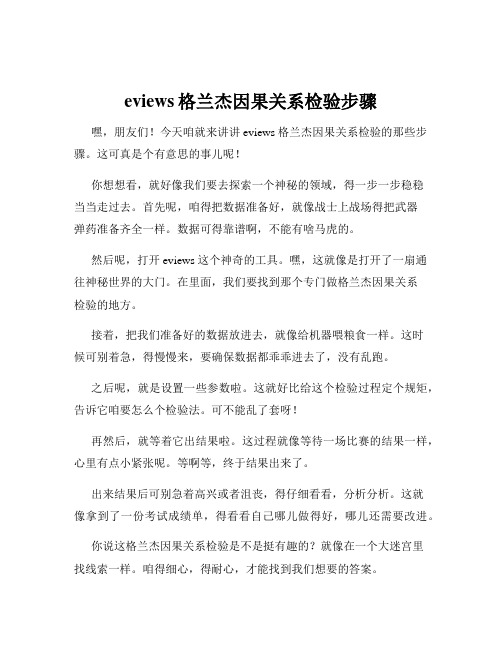
eviews格兰杰因果关系检验步骤嘿,朋友们!今天咱就来讲讲 eviews 格兰杰因果关系检验的那些步骤。
这可真是个有意思的事儿呢!你想想看,就好像我们要去探索一个神秘的领域,得一步一步稳稳当当走过去。
首先呢,咱得把数据准备好,就像战士上战场得把武器弹药准备齐全一样。
数据可得靠谱啊,不能有啥马虎的。
然后呢,打开 eviews 这个神奇的工具。
嘿,这就像是打开了一扇通往神秘世界的大门。
在里面,我们要找到那个专门做格兰杰因果关系检验的地方。
接着,把我们准备好的数据放进去,就像给机器喂粮食一样。
这时候可别着急,得慢慢来,要确保数据都乖乖进去了,没有乱跑。
之后呢,就是设置一些参数啦。
这就好比给这个检验过程定个规矩,告诉它咱要怎么个检验法。
可不能乱了套呀!再然后,就等着它出结果啦。
这过程就像等待一场比赛的结果一样,心里有点小紧张呢。
等啊等,终于结果出来了。
出来结果后可别急着高兴或者沮丧,得仔细看看,分析分析。
这就像拿到了一份考试成绩单,得看看自己哪儿做得好,哪儿还需要改进。
你说这格兰杰因果关系检验是不是挺有趣的?就像在一个大迷宫里找线索一样。
咱得细心,得耐心,才能找到我们想要的答案。
要是不按照这些步骤来,那可就像没头苍蝇一样乱撞啦,能得出啥好结果呢?所以啊,大家可得记住这些步骤,一步一步来。
在这个过程中,咱可能会遇到一些小麻烦,小挫折,但别怕呀!就像爬山一样,总会有难走的地方,但只要坚持,就能爬到山顶,看到美丽的风景。
总之呢,eviews 格兰杰因果关系检验步骤虽然有点多,但只要咱认真对待,肯定能搞明白的。
大家加油哦!别嫌麻烦,这可是探索知识的乐趣所在呀!。
- 1、下载文档前请自行甄别文档内容的完整性,平台不提供额外的编辑、内容补充、找答案等附加服务。
- 2、"仅部分预览"的文档,不可在线预览部分如存在完整性等问题,可反馈申请退款(可完整预览的文档不适用该条件!)。
- 3、如文档侵犯您的权益,请联系客服反馈,我们会尽快为您处理(人工客服工作时间:9:00-18:30)。
Eviews格兰杰因果关系检验结果说明一、经济变量之间的因果性问题计量经济模型的建立过程,本质上是用回归分析工具处理一个经济变量对其他经济变量的依存性问题,但这并不是暗示这个经济变量与其他经济变量间必然存在着因果关系。
由于没有因果关系的变量之间常常有很好的回归拟合,把回归模型的解释变量与被解释变量倒过来也能够拟合得很好,因此回归分析本身不能检验因果关系的存在性,也无法识别因果关系的方向。
假设两个变量,比如国内生产总值GDP和广义货币供给量M,各自都有滞后的分量GDP(-1),GDP(-2)…,M(-1),M(-2),…,显然这两个变量都存在着相互影响的关系。
但现在的问题是:究竟是M引起GDP的变化,还是GDP引起M的变化,或者两者间相互影响都存在反馈,即M引起GDP的变化,同时GDP也引起M的变化。
这些问题的实质是在两个变量间存在时间上的先后关系时,是否能够从统计意义上检验出因果性的方向,即在统计上确定GDP是M的因,还是M是GDP的因,或者M和GDP互为因果。
因果关系研究的有趣例子是回答“先有鸡还是先有蛋”的问题。
1988年有两位学者Walter N. Thurman和Mark E. Fisher用美国1930——1983年鸡蛋产量(EGGS)和鸡的产量(CHICKENS)的年度数据,对此问题进行了统计研究。
他们运用格兰杰的方法检验鸡和蛋之间的因果关系,结果发现,鸡生蛋的假设被拒绝,而蛋生鸡的假设成立,因此,蛋为因,鸡为果,也就是先有蛋。
他们并建议作其他诸如“谁笑在最后谁笑得最好”、“骄傲是失败之母”之类的格兰杰因果检验。
二、格兰杰因果关系检验strengthen the sense of responsibility, work to solve the lack of decent occupation explain away, conduct problems. To establish theoverall concept, eliminate departmentalism. Strict assessment and accountability, to solve the spiritual slack, nianqingpazhong, status quo, and other issues. To establish and perfect the muddle along Bureau staff conduct work regulations, standardize the behavior of personnel. 2. To strengthen the responsibility system. One is the in-depth study and implement the "Hunan provincial Party and government leading cadres Interim Provisions on the work safety of a pair of > (Hunan Officeissued 2013 No. 5)," Hunan province safety supervision and management responsibilities of the provisions on the production (Hunan Zhengban made 2013 No. 4) And resolutely implement the safety production of the party with responsibility, a pair of responsibility. "Two is issued safety production administration and inspection to promote the responsibilities bear safety production supervision departments strictly and effectively assumed responsibility. The three is to establish risk self correction self reporting system for safety in production enterprises, promote the enterprises to implement the mainresponsibility for production safety is introduced. Four strengthen the county safety production supervision ability construction work, promote safe production responsibility to the grassroots. 3, strictaccountability and target management. Adhere to the" who is in charge, who is responsible for the pipe industry must be safe, Guan Sheng production and operation must be safe, pipe business must controlsecurity "principle, the implementation of safety The production of "cure." stagnation supervision and leadership responsible system. The safety production of key towns, key enterprises and key problems, by the township government and the Department responsible for the stagnationled the lump sum, to tackle tough. To further increase the production safety index assessment, strictly implement the safety production of the "one vote veto" and the reward system, strengthen the safety incentive and restraint mechanism. (six) the implementation of the work force is not strong. The documents, meeting, long work arrangement, check and supervise the implementation of small, poor implementation of the system, the work is not effective. Some leading cadres sense of purpose, consciousness of the masses is not strong, the ruling " For the people "," the interests of the masses no matter "concept understanding is not in place. The specific work treats with the deployment, a few leading cadres complain that work is too complicated, too much responsibility, the pressure is too large, too much emphasis on the difficulty of the work, such as underground mines to avoid the disaster of" six systems "construction and construction of mechanical ventilation to file the form, forwarding arrangements work, no in-depth mining enterprises to promote the specific work, the increase in the number of files, but the effect is not good, not according to the actual situation of non coal mines in the county, to engage in" across the board ", and the quality 经济学家开拓了一种可以用来分析变量之间的因果的办法,即格兰杰因果关系检验。
该检验方法为2003年诺贝尔经济学奖得主克莱夫?格兰杰(Clive W. J.Granger)所开创,用于分析经济变量之间的因果关系。
他给因果关系的定义为“依赖于使用过去某些时点上所有信息的最佳最小二乘预测的方差。
”在时间序列情形下,两个经济变量X、Y之间的格兰杰因果关系定义为:若在包含了变量X、Y的过去信息的条件下,对变量Y的预测效果要优于只单独由Y的过去信息对Y进行的预测效果,即变量X有助于解释变量Y的将来变化,则认为变量X是引致变量Y的格兰杰原因。
进行格兰杰因果关系检验的一个前提条件是时间序列必须具有平稳性,否则可能会出现虚假回归问题。
因此在进行格兰杰因果关系检验之前首先应对各指标时间序列的平稳性进行单位根检验(unit root test)。
常用增广的迪基—富勒检验(ADF 检验)来分别对各指标序列的平稳性进行单位根检验。
格兰杰因果关系检验假设了有关y和x每一变量的预测的信息全部包含在这些变量的时间序列之中。
